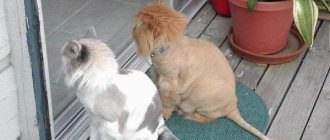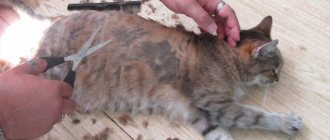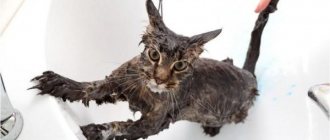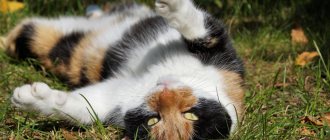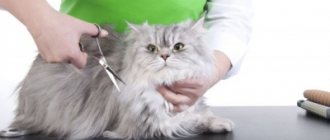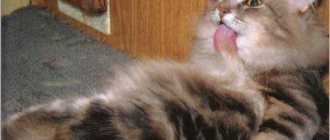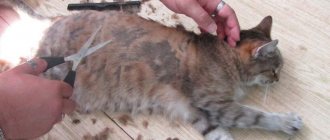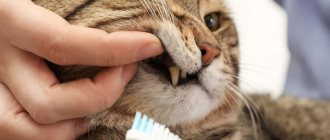Hygienic, high-quality care for pets is called grooming.
The complex of care measures includes combing out excess undercoat, haircut (sometimes shaving), bathing, cleaning the ears and plaque from the teeth, trimming and sealing the tips of the claws. Compared to dogs, cats require less maintenance to keep them hygienically clean. Many veterinarians believe that cats do not need partial or complete hair trimming, since such a procedure can cause more harm than good. And they recommend cutting your pet’s hair only when necessary.
Why shouldn't you cut cats?
Cats do not need a haircut: their fur creates a protective function, regulating body temperature and saving the paw pads from various injuries. These animals “wash themselves” by licking themselves and their relatives; combing itself with claws, thereby preventing the formation of tangles.
If the owner believes that his pet is suffering from the summer heat, then there is no need to rush into cutting it. It is enough to provide the cat with a cool place, for example in the bathroom, under an air conditioner, and you should also make sure that there are several bowls of water in the house.
Necessary accessories and preparation for a haircut
If, nevertheless, there is an urgent need to groom a cat, but the owner is afraid of injuring the pet and is not sure that he can cope with the procedure, you can contact grooming specialists in a professional salon. This operation is also included in the price list of many veterinary clinics.
In case of self-grooming at home, the animal owner must first purchase the necessary tools and equipment and perform certain actions:
- Prepare a table or wide ironing board as a grooming area.
- Buy large and small scissors with rounded tips and sharp blades made of high-quality steel, a furminator.
- Choose and buy a trimmer - a special machine for cutting animals. The optimal nozzle for cats is usually 3 mm. The device cannot be used on human hair, as cats have a completely different hair structure. You also need to decide on the power of the device, so for Persians it needs high (45-60 W), for semi-long-haired pets you can limit yourself to 20 W.
- Make sure there is minimal stress for the cat. Thus, more powerful rotary trimmers make a lot of noise and frighten the animal; it is worth choosing a model with a mains adapter and a vibration-type motor.
- The cat may need to be given sedatives the day before the procedure. It should be remembered that synthetic substances and anesthesia will harm your pet; it is better to use herbal products.
- Sometimes it is advisable to use an Elizabethan collar - a special device worn around the animal’s neck. It can prevent a nervous cat from biting and injuring the groomer. A special muzzle can also help - a cap that covers the cat’s mouth and eyes.
- Most likely, you will need a special machine for cutting hair on the paw pads, face, around the genitals, and in other hard-to-reach places.
- It is necessary to provide thinning scissors and a massage brush to bring the hairstyle to its final shine. Also, for some (especially short-haired breeds) cats, you will need velvet for polishing, wet wipes to remove excess hair, or a special glove.
- It is also worth making sure that you have on hand the means to provide first aid to your pet if an accidental injury to the skin occurs. It is better not to use alcohol-containing compounds (iodine), but to purchase hydrogen peroxide, Miramistin, Chlorhexidine, and special talc.
You should invite another person as an assistant, and the pet itself should have its claws trimmed at least 24 hours in advance.
Reasons why it is not advisable to cut your cat's hair
The opinions of veterinarians vary, but on some points they are unanimous:
The process of shearing is a strong shock and stress for the animal. As a result, a decrease in the body's immune defense may occur.- Due to frequent haircuts, the coat becomes thinner, which contributes to the formation of tangles more frequently.
- Constant haircuts can change the color, structure of the coat and undercoat. It becomes dull and brittle.
- The cat's skin becomes drier, often causes itching and leads to scratching, which will then have to be treated for a long time.
Veterinarians strongly do not recommend cutting cats with short-haired breeds or those with medium-length hair:
- Burmese,
- Maine Coon,
- Norwegian forest cats,
- redgolls,
- Siberian cats,
- Turkish Angoras.
Their fur has a special structure and differs significantly from other species: it consists of two layers and has different hair lengths. A hairless cat can easily become overheated or hypothermic.
Is it possible to shave a cat's head?
Animal wool plays a big role: it protects against hypothermia, sun rays, and protects the skin from accidental damage. Cats that are constantly kept indoors are no less susceptible to injury than street cats.
Shaving the head is strictly prohibited: sensitive vibrissae are located here, damage to which is contraindicated. Hair cutting bald is an extreme measure, permissible if it is impossible to remove building mortars and foam from the coat, and it is also necessary before surgery. In other cases, shaving your pet will not bring any benefit, but can cause the development of colds.
In addition to the above, it is unknown how long the wool will take to recover. This usually happens within six months, but if there is a lack of nutrients, the process can drag on for several years.
When is a cat's haircut necessary?
There are situations when a four-legged friend really needs to cut his fur coat. Let's look at the main ones:
When a cat has a large number of mats of different sizes. Combing the animal in such cases may not always give results, since the tangles very quickly form dense wool balls, which are easier to cut out. In addition to being unsightly, tangles cause discomfort and health problems for your pet. By tightening the skin, they interfere with blood flow and cause itching. After all, by their nature, cats are very clean; they will try to get rid of the formed tangles on their own, scratching and gnawing out the lumps. But this is dangerous for the pet - he may accidentally swallow a hairball, which can block the passage in the digestive tract or cause severe vomiting.- Skin disease. It can be recognized by the appearance of weeping ulcers on the skin. The thick coat will make it difficult to treat with medications and will not provide adequate ventilation.
- Long molting. It can be caused by various reasons from skin problems to metabolic disorders. It is worth consulting a doctor in a timely manner.
- One of the family members has a wool allergy. But this method of getting rid of wool in the house is ineffective. After cutting, the amount of hair will decrease in volume, but if a person has an acute allergic reaction to wool, then the number of hairs on the pet’s body does not matter. We will have to look for other ways to combat allergies.
There are some cats that physically cannot take care of themselves. This is mainly due to age. Their fur will look dirty and unkempt, so it's best to keep it trimmed.
In what cases can you not do without a haircut?
Most owners have their own opinion about the indications for grooming a cat:
- getting rid of fur on furniture and carpets during seasonal shedding;
- allergies in the owner and family members (a shorn animal has less fluff, which causes an allergic reaction);
- prevention of overheating (in the summer, cats are hot due to their thick fur coat);
- solving problems with hair (it is easier to remove fleas, ticks, burrs).
Owning a representative of a long-haired breed while suffering from allergies, helping a pet in the heat, solving the problem of seasonal shedding - experts treat such wishes with irony. These are the whims of the owners, and not a real need. Professionals allow haircuts only in two cases:
- To get rid of large tangles. Matted fur causes pain and itching, and involuntary scratching of problem areas. When there is a massive accumulation of them, the cat is cut to relieve discomfort and prevent the development of dermatological diseases.
- As part of preoperative preparation. Before surgical interventions, the animal is not only cut short, but also shaved.
A cat’s beautiful hairstyle pleases its owners, not the cat itself. An incorrectly trimmed tail can even cause your pet to try to chew it off.
Types of haircuts for cats
A special hygienic haircut is carried out no more than twice a year, so as not to damage the structure of the coat and skin. If the cat must participate in an exhibition, the last haircut is done no later than six months before the event.
Trimming is usually done with a special clipper, leaving a hair length of approximately 3-3.5 millimeters. After this procedure, the animal’s skin becomes soft and velvety to the touch.
It is not advisable to cut your cat’s hair on your own, since a high-quality result will require many special tools:
- different types of hairdressing scissors,
- hair clipper,
- set of combs
It is forbidden to cut cats completely, that is, bald. This will disrupt the heat exchange process and can soon cause serious skin irritation.
Therefore, when grooming an animal, it is necessary to leave at least a minimum length of hair to protect it from sunburn or hypothermia.
Description and photo
Sometimes, for stylish reasons, show cats are given a model look by experimenting with types of trimming. There are many options for such haircuts now, but let’s look at the most popular ones:
- "Puma" - short hair on the body, and the head looks like a lion's mane;
- “Dragon” is a curly haircut in which hairs are left along the line of the spine, and various figures or symbols are cut from them;
- “Golfies” - hair is removed only on the upper part of the paws.
Is it possible to shave a cat bald?
The answer to the question whether it is necessary and whether it is possible to cut a cat’s fur will be both “yes” and “no”. You definitely can’t completely shave a cat. But a 3 mm haircut is sometimes indicated. There are situations in which a cat needs to be shaved. These are, first of all, medical indications for such a procedure as a hygienic haircut:
- foci of fungus and other skin infections;
- a large number of tangles, when it is easier to shave them than to cut them out;
- weeping wounds and ulcers: shaving in such cases is indicated on the affected areas to make it easier to apply medications;
- the animal became so dirty that it was impossible to wash it off;
- shaving certain areas before surgery and ultrasound;
- the animal sheds heavily and swallows a huge amount of hair, which creates a threat of blockage of the gastrointestinal tract: in this case, you can shave until the cause of excessive shedding is eliminated.
Shaving, indeed, allows you to stop severe shedding when the house is literally drowning in fur. This helped in our situation: we went to the groomers with a request to comb out the hair, but in the end they solved the problem completely. Naturally, if the cat is prone to such shedding, as soon as the fur grows back and the season comes, the problem will arise again. Those. shaving, in fact, does not solve the problem, but only hides it: short hairs continue to fall out, but this is no longer noticeable.
What happens if you shave a cat's head directly depends on the color and individual mental traits of the cat, as well as on the conditions in which it lives. For example, smoke-colored cats are cut and shaved with great care, but color-point cats should not be cut or shaved. Many who are reading these lines now will object, they say, they have points, they were shaved - and everything is fine. Yes, some points are fine. But in the classic version, the points darken after that. Tested on mine and many other cats. Smoky and tipped colors also run the risk of deterioration.
Article continues after advertisement
As for other conditions, many cats have a psychologically difficult time with the shaving process and its consequences. And also, because In cats, after shaving, the heat exchange that is maintained by the hair is disrupted; in the first time after the procedure, the cat may freeze, even despite the warmth around.
How to trim or shave a pet?
There is nothing complicated in grooming a cat if you follow the rules and sequence of actions:
- Nail trimming. The claws are trimmed with special tweezers, having been disinfected in advance. When you lightly press the paw pads, the hidden claws will extend. The owner will need to trim only the very ends.
- To begin with, you may need an assistant - he will hold the animal, preventing it from running away. Some cats react aggressively to the appearance of grooming tools. For the safety of the owner and the pet itself, it is worth putting a special plastic collar on the animal that does not allow it to bite.
The cat is laid on its side, its paws are fixed. To cut, you need a machine or scissors. The machine will help avoid damage to the skin, but can be frightening with its buzzing.- First, the hair is removed from the sides, and then moved to the back and belly. You need to remove hair as it grows, and in the opposite direction. Hair that remains long after cutting with a clipper can be trimmed with nail scissors. There must be a tassel on the tail.
- At the end of the procedure, the pet must be bathed with a special shampoo for cats, and then dried with a towel. If your pet is not afraid of a hair dryer, it can also be used for drying. But veterinarians still recommend going to a professional groomer. Because he is a competent and qualified specialist. He will do the haircut quickly and without any damage.
When performing a haircut of any shape, there are certain rules:
- in order not to damage the mustache and hair in the ears, the hair on the head, muzzle and in the auricle is not cut;
- “socks” are left on the lower part of the legs;
- the hairs of the front legs under the elbow and from the hind legs under the jumping joint are not removed;
- the hair is left at the end of the tail (a section at least 3 cm long must be left uncut).
Is it worth shaving cats in the heat: how to help our smaller brothers
Let's say thank you to Facebook: more and more aspects of other people's private lives are becoming public knowledge - and there is no need to peek through the keyhole. So, for example, short-haired cats and female cats—cats, as they are usually called on the Internet—filled all friend feeds in the summer. Cropped cats look, perhaps, strange: something very similar to how medieval artists depicted lions - a fluffy head, paws and a naked body with a tassel on the tail. To collect mi-mi-mi-likes on social networks - just right? Do the animals themselves need a fashionable haircut?
- Long-haired cats definitely need to be cut. For example, Persian, Siberian cats or Maine Coons - for them this is a normal hygiene procedure. During the molting period, tangles often form, resulting in the fur coat not allowing air to pass through. And it is best to do this in the summer, so that the animal can more easily endure the heat. There is no stress for the animal: the velor layer grows in about a week, so the cat will not walk around with bare skin,” felinologist Angelina Sirotina assured MK.
However, when you look at shaved cats, you get a different impression: sometimes it seems that the shaved Persian, once proud and friendly, is now embarrassed to appear in public in an inappropriate manner. The devil will understand what's going on in a cat's head... In any case, such experiments are definitely not worth doing on other breeds: according to a felinologist, for the British, for example, just regular combing and periodic washing is enough (cats, by the way, also need to be washed with both shampoo and conditioner for easy combing and soft hair!). Other experts believe that a tangle cutter and a brush will suffice when caring for furry beauties.
“I don’t recommend shaving Maine Coons,” felinologist and breeder Galina Shelyakina explained in a conversation with an MK correspondent. “Their fur grows quite poorly; this process can take two years. I believe that the animal will be uncomfortable in winter, although in principle they tolerate shaving just fine if they are not wet or placed on wet surfaces. But in general, wool provides additional thermoregulation, so sometimes it is better to leave the animal as is.
To make life easier for a pet in the heat, other, reversible methods have been invented in the 21st century. For example, special cooling mats, collars or even blankets with hydrogel. They maintain a temperature of 17–18 degrees, which is comfortable for the animal. In addition, you can use a popular life hack: moisten a cloth with water and tie it on the animal’s head like a bandana - however, you must be careful that water does not get into the cat’s ears (and not every cat will agree to wear a hat).
Dogs suffer in the heat no less than their meowing colleagues. The worst thing at high temperatures is for animals with black fur, short-haired and hairless pets (they can simply burn in the sun), as well as dogs with a flat face - they have difficulty breathing. We are talking about pugs, bulldogs, Rottweilers and other breeds. Decorative dogs that have poor thermoregulation, such as Chihuahuas, are also at risk. In addition, pets with thick undercoat, such as huskies, huskies, and malamutes, do not tolerate heat well. On the other hand, there are breeds that can tolerate moderately high temperatures completely painlessly: Yorkies, poodles, Italian greyhounds. It gets a little hard in the summer for older dogs and sick animals.
You can understand that an animal is overheated by various signs. To cool down a little, a dog can stick out its tongue and breathe very quickly, because there are few sweat glands in its body. In addition, she drinks a lot and refuses to eat, the dog is lethargic, apathetic, and slow. If you don’t help the poor animal in any way, then the symptoms will be even more serious - breathing will become shallow, the pulse will be thready, the tongue will turn blue, the eyes will turn red... These signs indicate serious overheating.
Veterinarians advise not to take things to extremes, but to provide first aid to the dog. You need to put the pet on its side, wet its paws, back of the head and stomach, and measure its temperature. The procedure is not the most pleasant for both the owner and the animal - the thermometer is inserted rectally. If the temperature is above 39.5, then you need to continue to cool the poor thing by covering it with cold towels until the thermometer reads 38.5. If the dog has lost consciousness, it should be wrapped in a cold towel and immediately taken to the veterinarian.
To make your four-legged friend feel good in the heat, you can follow a few simple rules - prevention is sometimes the best cure. The simplest and most obvious thing is not to walk your dog during the hottest time of the day. There is no need to drag her into the heat from 11 am to 5 pm. If you really want to go out during the day, then walk in the shade or on the shore of a pond, but no longer than 15 minutes. If possible, it is better not to drag your dog along hot asphalt or paving stones - unfortunately, he is not allowed platform sandals, and the skin of his paws will be painful. Or actually buy her boots. Veterinarians advise not to wear a muzzle in hot weather - it makes breathing difficult, and to wear a light blanket made of light fabric on brunette dogs. Naturally, your pet should always have water in his bowl. It is better to feed light and low-fat foods twice a day. On the other hand, you don’t need to freeze the animal very much - don’t leave it on a cold tiled floor under air conditioners, don’t throw it suddenly into cold water - in general, everything is like with people. And the last piece of advice that owners often forget is to not tie up the dog in the sun or leave it in a stuffy, locked car.
Benefits and harms
Like any grooming procedure, cat trimming has its positive and negative properties. Let's look at them in detail.
Pros:
Relief from heat and health problems. There is a very common stereotype that representatives of long-haired breeds suffer from heat, especially during the hot season.- It is necessary to cut a cat if for some reason (for example, due to age) it cannot care for its fur, and you do not have the opportunity to constantly care for it. All this can soon lead to a visit to the veterinarian, and in worst cases, to surgery.
- Caring for a cat can also save the lives of owners who suffer from allergies or asthma. It will help eliminate the factor leading to suffocation and exacerbation of the disease.
Minuses:
- Many cats have a negative attitude towards haircuts. It, like bathing, causes discomfort and stress for the cat. After this, the pet may be depressed, and due to resentment, it may even become offended and ignore the owner. Particularly proud pets can leave a “surprise” in their owner’s slippers in retaliation for an attack on their fur coat.
- After cutting, the cats' hairs become a little smaller. Even the color of the animal may become lighter. If the coat is shortened too much, the animal will feel unwell and may experience dryness and loss of elasticity.
- There are cases when in some areas of the skin the hair does not grow back after cutting. This means that alopecia appears. This is caused by hypothermia and improper hair growth. This condition is mainly characteristic of dogs, but there have been cases when it also occurred in cats. If baldness began to appear even before the cut, do not try to solve the problem: here you need to contact a veterinarian.
How long does a cat's hair grow after shaving?
How long a cat's fur grows after trimming and shaving is mainly influenced by genetics and nutritional balance. For example, my cat gained about 2 mm in length in 1-2 days. This is the normal rate of hair growth for cats. At first it looked like a waffle towel - a pitiful sight, although it was pleasant to touch (reminiscent of a mouton). Two weeks passed and the animal was in more or less decent shape. After about six months, as the groomers promised, the coat regained its previous length. On average, this is what happens.
However, as expected, the blue point cat was very dark on the body. It looks disgusting, so we're waiting for it to fade. There is little hope that after molting, the previous light shade will at least be restored a little.
But many owners complain that the cat’s hair does not grow well after a haircut. This also happens. And in rare cases, there may be areas of baldness where the hair does not recover at all.
Why do they cut their hair?
Many owners prefer to take their furry dog to the procedure to give it an aesthetic shine.
More often, owners cut their furry pets for the following reasons:
- Hot Summer;
- prolonged molting;
- skin diseases;
- decorative haircut;
- getting hair into the stomach.
Experts recommend haircuts only when tangles appear that cannot be combed out, and for certain skin ailments: dermatitis or lichen.

